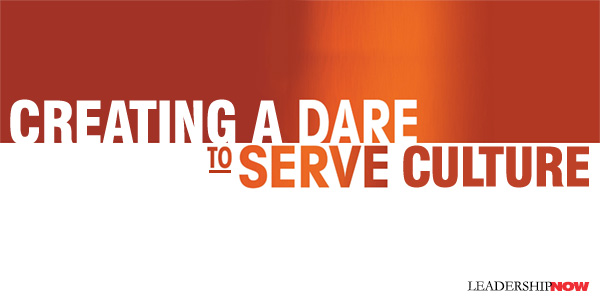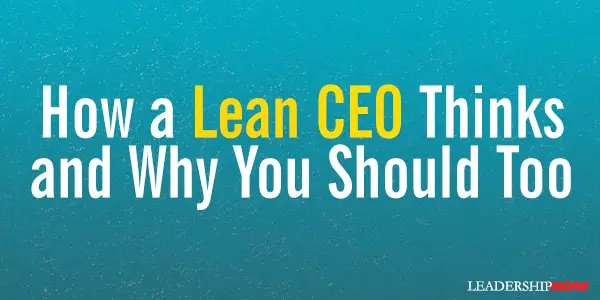 Leading Blog | Posts by Month |
 Leading Blog | Posts by Month |
04.30.15

LeadershipNow 140: April 2015 Compilation
See more on
Posted by Michael McKinney at 09:26 AM
04.29.15

Creating a Dare-to-Serve Culture
COMMAND and control is a leadership style that is in many ways our default leadership position. It’s very human. Leadership that serves is far more demanding of a leader. These demands easily drive us back into our old styles of leadership. It’s the daily grind that derails our best intentions.
Bachelder lists five benefits to becoming a Dare-to-Serve Leader:
What do you believe enough to act on? These are core beliefs that are so important to you that you will act promptly to rectify the situation when they are violated. Dare-to-Serve Leaders act on three core beliefs: human dignity, personal responsibility, and humility. We tend to be careless with human dignity says Bachelder. We don’t listen, we are impatient, we publicly criticize, and joke in ways that hurt. Push your daily situations through a filter of what you would like someone to do for you. “Lack of personal responsibility in a leader is just another form of self-absorption.” You must look at yourself and understand your own imperfections. “You will have no capacity to serve others unless you can take responsibility for your own self.” Humility is the “behavior” that makes it all work. “We agreed that we are not naturally humble either. That means there are plenty of days we are hell to work for, too. Therefore, humility must be a principle that we have conviction about—or we will never demonstrate humility to our teams. This principle will forever be an aspiration, not an accomplishment. As hard as we try, we will repeatedly fall short.” Bachelder has included 40 reflections for Dare-to-Serve Leaders to help you think about the leader you are. How do you gain meaningful feedback from those you serve?

Posted by Michael McKinney at 11:30 PM
04.22.15

How a Lean CEO Thinks and Why You Should Too The Lean CEO by Jacob Stoller gets to the thinking behind why Lean management works. I think "Lean" is a poor moniker to give the approach. It tends to make people think of cost-cutting or how to get the most work out of the fewest number of people. It sounds like a manufacturing thing. But that is misleading.
The Lean CEO by Jacob Stoller gets to the thinking behind why Lean management works. I think "Lean" is a poor moniker to give the approach. It tends to make people think of cost-cutting or how to get the most work out of the fewest number of people. It sounds like a manufacturing thing. But that is misleading.
It is a holistic approach to management. It produces excellence because it is good leadership. It is “a fundamental overhaul in the way companies manage people.” To be sure it is about creating the most value from the resources you have whether it be time, money, people, or equipment. It strips away any event that does not add value by creating leaders at all levels. Stoller points out, Lean organizations outperform non-Lean organizations for two basic reasons: Lean Brings Out the Best in People Lean is respectful of people, develops and makes use of people’s gifts. “Lean provides the antidote for the common complaint ‘I love my work, but I can’t stand all the other stuff that goes on.’ Lean sees that ‘other stuff’ as waste, and any employee who feels that frustration can lead the charge to get rid of that waste.” It builds teamwork. How can we produce the best work together? Lean Gets Leaders in Touch with Reality Management does not lack data. What is typically lacking is context. Lean provides that context. It connects every member of the team to what is really going on. A Lean organization is essentially a learning organization which makes it especially suited for uncertain times. “Lean provides a disciplined structure that allows an organization to focus resources on measurable customer-oriented goals, essentially codifying what has made the company successful. Because Lean creates a continuous improvement environment where all employees are asked for input on decisions, the Lean journey allows the CEO to naturally evolve from reactive day-to-day decision maker to proactive teacher, coach, and strategist.” Stoller begins The Lean CEO with an exceptional survey of how we got to be so wasteful. Wasteful of people’s time, energy, and talent in particular. Abundance often leads to waste and hides issues that should be dealt with. Many Lean CEOs would not have adopted Lean practices without a crisis. Stoller profiles 28 Lean CEOs in this book that have implemented Lean in a variety of industries with great success. There is a lot to glean from these pages. Here are some ideas to reflect on: Lean creates the ideal environment for motivating workers. Recognition, variety, autonomy, and the opportunity to learn are all intrinsic to the employee’s role in a culture of continuous improvement. Lean is not just a manufacturing system. It is a way of thinking about people that applies to any organization. Lean is a culture. It’s not a directive. It’s a way of thinking. It is about being open and humble. It’s about diversity of thought and understanding that good ideas come from anywhere. The Lean CEO gets to the heart of what it means to lead from anywhere. 
Posted by Michael McKinney at 10:54 PM
04.15.15

Cleaning the Toilet Can Make You a Better Leader As a leader you are more than an individual contributor. Leaders think about the context—the big picture—not just their function. Focused on the outcome, they do whatever needs to be done to move the organization forward. They do whatever they can to facilitate the work of others. Leaders are connected to what others are doing. And we can accomplish this be asking, “How can I help you?” And then doing what needs to be done. Michael Janda Founder of the creative agency RiSER, put it this way in Burn Your Portfolio: I believe you are a better person if you’ve ever had a job that required you to clean a public restroom. This humbling task teaches so many lessons, among which is the willingness to do whatever the job requires. I have seen over and over again in my career that the people who are willing to go the extra mile and do whatever task is required of them by their boss or client are among the most valued in the company.Doing what needs to be done—including cleaning toilets—is taking ownership for the outcome. Going the extra mile—doing what needs to be done—helps to create a true culture of leadership in your organization—by example. We don’t serve because we are leaders, we have the privilege to lead because we serve.
Posted by Michael McKinney at 09:34 PM
04.01.15

First Look: Leadership Books for April 2015Here's a look at some of the best leadership books to be released in April.




For bulk orders call 1-800-423-8273  Build your leadership library with these specials on over 100 titles. All titles are at least 40% off the list price and are available only in limited quantities.
Posted by Michael McKinney at 08:10 AM
|
BUILD YOUR KNOWLEDGE


How to Do Your Start-Up Right STRAIGHT TALK FOR START-UPS 
Grow Your Leadership Skills NEW AND UPCOMING LEADERSHIP BOOKS 
Leadership Minute BITE-SIZE CONCEPTS YOU CAN CHEW ON 
Classic Leadership Books BOOKS TO READ BEFORE YOU LEAD |
|